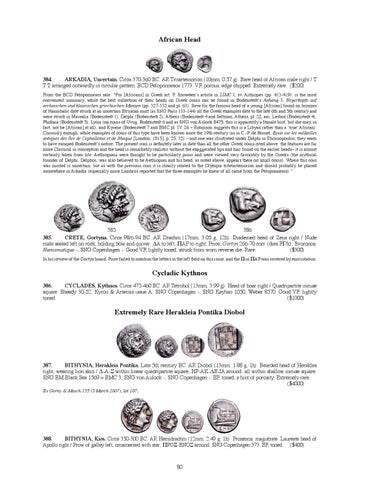African Head
384. ARKADIA, Uncertain. Circa 370-360 BC. AR Tritartemorion (10mm, 0.57 g). Bare head of African male right / T T T arranged outwardly in circular pattern. BCD Peloponnesos 1773. VF, porous, edge chipped. Extremely rare. ($200) From the BCD Peloponnesos sale: “For [Africans] in Greek art, F. Snowden’s article in LIMC I, sv. Aithiopes (pp. 413-419), is the most convenient summary, while the best collection of their heads on Greek coins can be found in Bodenstedt’s Anhang 3, Negerköpfe auf archaischen und klassischen griechischen Münzen (pp. 327-332 and pl. 63). Save for the famous head of a young [African] found on bronzes of Hannibalic date struck at an uncertain Etruscan mint (as SNG Paris 133-144) all the Greek examples date to the late 6th and 5th century and were struck in Massalia (Bodenstedt 1), Delphi (Bodenstedt 2), Athens (Bodenstedt 4 and Seltman, Athens, pl. 22, aa), Lesbos (Bodenstedt 4), Phokaia (Bodenstedt 5), Lycia (on coins of Uvug, Bodenstedt 6 and as SNG von Aulock 8475; this is apparently a female bust, but she may, in fact, not be [African] at all), and Kyrene (Bodenstedt 7 and BMC pl. IV, 26 – Robinson suggests this is a Libyan rather than a ‘true’ African). Curiously enough, while examples of coins of this type have been known since the 19th century (as in C.-P. de Bosset, Essai sur les médailles antiques des îles de Cephallonie et de Ithaque [London, 1815], p. 25, 32) – and one was illustrated under Delphi in Rhousopoulos, they seem to have escaped Bodenstedt’s notice. The present coin is definitely later in date than all the other Greek coins cited above: the features are far more Classical in conception and the head is remarkably realistic without the exaggerated lips and hair found on the earlier heads– it is almost certainly taken from life. Aethiopians were thought to be particularly pious and were viewed very favorably by the Greeks (the mythical founder of Delphi, Delphos, was also believed to be Aethiopian and his head, as noted above, appears there on small coins). Where this coin was minted is uncertain; but as with the previous coin it is clearly related to the Olympia tritetartemorion and should probably be placed somewhere in Arkadia (especially since Lambros reported that the three examples he knew of all came from the Peloponnesos).”
385 386 385. CRETE, Gortyna. Circa 98/6-94 BC. AR Drachm (17mm, 3.05 g, 12h). Diademed head of Zeus right / Nude male seated left on rock, holding bow and quiver; ΔA to left, ΠAP to right. Price, Gortyn 266-70 corr. (dies FΓ/k); Svoronos, Numismatique -; SNG Copenhagen -. Good VF, lightly toned, struck from worn reverse die. Rare. ($300) In his review of the Gortyn hoard, Price failed to mention the letters in the left field on this issue, and the Π in ΠAP was covered by encrustation.
Cycladic Kythnos 386. CYCLADES, Kythnos. Circa 475-460 BC. AR Tetrobol (13mm, 3.99 g). Head of boar right / Quadripartite incuse square. Sheedy 30-52; Kyrou & Artemis issue A; SNG Copenhagen -; SNG Kayhan 1050; Weber 8570. Good VF, lightly toned. ($1000)
Extremely Rare Herakleia Pontika Diobol
387. BITHYNIA, Herakleia Pontika. Late 5th century BC. AR Diobol (13mm, 1.88 g, 1h). Bearded head of Herakles right, wearing lion skin / Δ-A-Σ within linear quadripartite square; HP-AK-ΛE-IA around; all within shallow incuse square. SNG BM Black Sea 1569 = BMC 3; SNG von Aulock -; SNG Copenhagen -. EF, toned, a hint of porosity. Extremely rare. ($4000) Ex Gorny & Mosch 155 (5 March 2007), lot 107.
388. BITHYNIA, Kios. Circa 350-300 BC. AR Hemidrachm (12mm, 2.49 g, 1h). Proxenos, magistrate. Laureate head of Apollo right / Prow of galley left, ornamented with star; ΠPOΞ-ENOΣ around. SNG Copenhagen 373. EF, toned. ($400) 80
